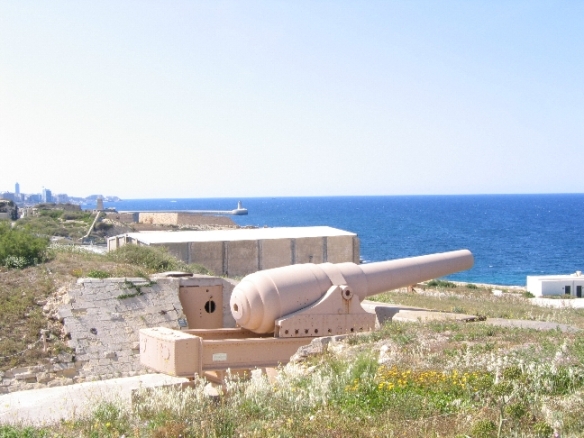Rinella gun, Malta, still on the original mount.
In the late 1800s, large muzzle-loading cannons were built by Armstrong’s Elswick Ordnance Company for the British government. They were built on the Armstrong system of a primary steel tube, with successive, shorter, wrought-iron tubes, heated and shrunk on the main tube. They had a 18-in (45-cm) bore, a little over 30ft (9m) long. The guns were first fired in 1884, but the weapons were not fully operational until 1889 owing to hydraulic system problems. The four original British guns were divided between Gibraltar and Malta and none of them were ever fired in earnest.
During the 1860s and 1870s, Woolwich manufactured several marks of large naval and seacoast Armstrong muzzleloaders, ranging from the 12-ton, 9-inch Mk IV to the 81-ton, 16-inch Mk I. Other big Armstrongs included the 38-ton, 12.5-inch Mk I; the 35-ton, 12- inch Mk I; the 25-ton, 12-inch Mk II; the 25-ton, 11-inch Mk II; and the 18-ton, 10-inch Mk II. The largest rifled muzzleloaders in British service were 17.72-inch, 100-ton giants that, with a 460- pound charge, fired a 1-ton projectile at a muzzle velocity of nearly 1,700 feet per second. Four were manufactured and were mounted in the defenses of Gibraltar and Malta.
The largest muzzleloading black powder cannons ever built were the Armstrong 100-ton guns which saw service with the Italian Navy and with British coastal fortifications on Malta and Gibraltar. They were purchased by the Italians first, to outfit a pair of new super battleships, each vessel having two turrets with two of these guns in each. To avoid being outclassed, the British ordered two guns for installation to protect the Grand Harbor of Malta and two more to protect Gibraltar. Today one survives at each location, and we are visiting the Rinella Battery in Malta, which was built to house one of the Maltese guns.
These guns had a maximum range of 8 miles, and was capable of piercing 15 inches of iron armor at 3 miles. It had a 17.7 inch (45cm) bore fired a 2000 pound (900 kg) shell with a 450 pound (200kg) charge of black powder. The gun itself weighed approximately 102 tons, and with its cradle and a shell the whole assembly came in at 150 tons.
Aside from the massive scale of the piece, the most interesting part of its design is actually the loading machinery. Because of the titanic size of the gun and ammunition, Armstrong designed a fascinating hydraulic reloading facility which makes up the body of the fortress in which the gun is set. A pair of steam engines drove a pair of hydraulic accumulators, which provided hydraulic pressure to move the gun on its carriage, to douse the barrel after firing, to hoist ammunition into position for loading and power a 60-foot (18m) ramrod to mechanically ram the charge and shell into place. Two mirror-image reloading galleries under the fortification operated in turn, giving the gun a sustained rate of fire of 1 round every 6 minutes – at least until its 120-round barrel life was exhausted.
Malta Batteries
In 1866, four coastal batteries were proposed, two on either side of the main harbor area. On the northwest side were established Sliema Point Battery and Fort Pembroke, while on the southeast side were Fort St. Rocco and Fort St. Tombrell. The Sliema Point Battery was built in 1876 with two eleven-inch and two ten-inch guns. In 1879 work began on Fort Pembroke, overlooking St. George’s Bay. It was completed at a cost of 13,730 pounds. The seventy troops stationed there serviced three thirty-five-ton twelve-inch rifled muzzle loader (RML) guns with a range of 10,000 yards.
Originally, these new coastal batteries were to be armed with twenty three-ton RML guns, but with the rapid development of technology, it became necessary to increase their size during construction, some being eventually armed with thirty-eight-ton RML guns firing 12.5-inch shells. Likewise, the protection of the batteries was repeatedly upgraded. While five inches of protective iron had been sufficient previous to 1866, the introduction of the twenty-three-ton gun led this to be increased to twelve inches. By 1878, twenty-eight inches of armor plating was deemed necessary to withstand the bombardment of the largest ironclad battleships.
It would seem that in their long possession of the islands, the knights had fortified every conceivable spot in the main harbor area. But if there was a chink in the armor, it was the Corradino Heights, directly across from Floriana and Valletta. The Turkish army had established batteries there in 1565, and the Hornwork at Floriana had been constructed to deal with any future threats from that direction. The British decided to build entrenchments on these heights and in 1871 began work on the Corradino Lines. These were completed in 1880 at a cost of 17,634 pounds and featured two sixty-four-pound RMLs.
Additional artillery positions were built around the main harbor area. On the northern or Marsamxett side, Fort Cambridge was built on the Sliema peninsula. It featured a single 100-ton RML, the heaviest muzzle loader ever built, with a maximum range of 14,000 yards, a gun crew of thirty-five, and firing a 17.72-inch shell. Begun in 1878, it was not completed until 1898 at a cost of over 19,000 pounds. Another new position on this side of the harbor area was Garden Battery, which was sandwiched between Fort Tigne and Fort Cambridge. It was completed in 1894 at cost of 7,806 pounds and armed with one 9.2-inch breech-loading (BL) gun and two 6-inch BL guns, all on disappearing mountings.
On the opposite or Grand Harbour side, the British built Fort Rinella, featuring another 100-ton gun similar to that in Fort Cambridge. Its massive artillery piece was mounted on January 12, 1888, with great ceremony. Delia Grazie Battery was then constructed between forts Ricasoli and Rinella. Completed in 1893, it was armed with two ten-inch and two six-inch BL guns, costing 16,344 pounds.
